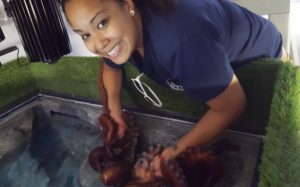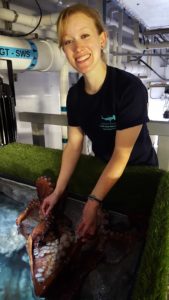Playing with an octopus isn’t in everyone’s job description. But for aquarium staff Paige Gutierrez and Tai Fripp, it’s all part of caring for Ozzie, the giant Pacific octopus inside the Pacific Seas Aquarium at Point Defiance Zoo & Aquarium. Why? Because an octopus is curious – and if an aquarist is cleaning her habitat, she wants to join in the fun.

“She’s strong, and so curious,” says Mikiko Williams, the staff biologist who is Ozzie’s primary caregiver – and the aquarist who most often suits up in scuba gear to clean out the octopus’ habitat. “While I’m working, there is always someone at the top distracting Ozzie, or she would climb all over me. She would even play with my mask, so it’s a safety thing as well.”
So how, exactly, does one distract an octopus?
First, it helps to understand them. A giant Pacific octopus has two rows of suction cups on each of its eight arms – up to 2,240 suckers in a female like Ozzie – which it uses to explore its environment through smell and taste, each arm working independently of the brain. Octopuses are very intelligent creatures who can solve puzzles, open jars and manipulate their environment, as well as interact with the humans who care for them. Given the chance, they’ll explore anything around them.

Add in a prodigious strength and a six-foot arm span, and you start to realize what distracting an octopus involves.
Leaning over the edge of the water, the distractor gently offers Ozzie his or her bare arms to explore, encouraging her to stay inside and away from Williams as the aquarist cleans. Her suckers clamp on and peel off, damp and grippy; her arms curl and extend almost faster than you can predict. It’s a friendly interaction, but it definitely requires some muscle on the human’s part.
And yes, those suckers can leave red marks, though they’re neither painful nor permanent.
Mostly, though, the experience of being explored by an octopus is a unique delight – a chance to communicate non-verbally with another intelligent species.
“She’s an amazing animal, so smart and playful,” Williams says. “It’s such a privilege to care for her.”
SEE THE OCTOPUS: See Ozzie the giant Pacific octopus every day in the Pacific Seas Aquarium.
-Rosemary Ponnekanti, PDZA